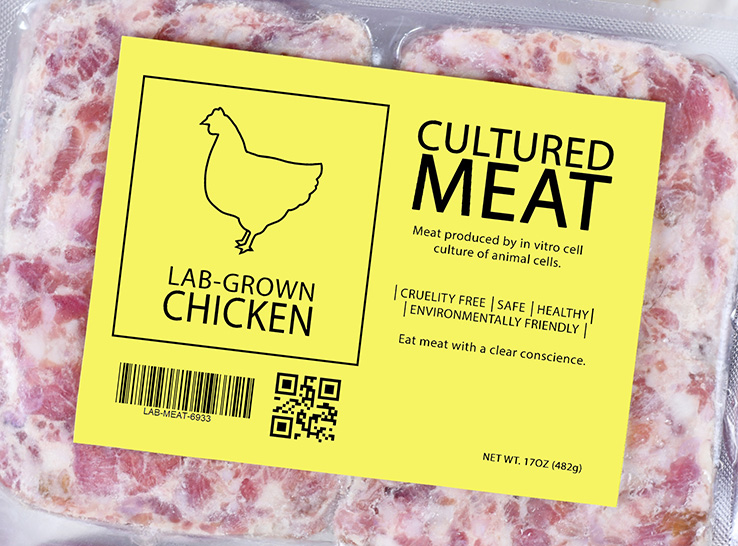In June 2023, the USDA Food Safety Inspection Service (FSIS), approved the sale of cell-cultured (sometimes called “lab-grown”) chicken by two California companies. The US joins Singapore as the only countries in which cell-cultured chicken is approved for sale to consumers.
What is cell-cultured chicken? How is it labeled? What is its impact on energy consumption and the environment?
National Chicken Council’s Tom Super, senior vice president of communications, recently addressed these and other questions for the poultry industry.
What is cell-cultured chicken?
Cell-cultured chicken is synthesized (or manufactured) from animal cell culture technology using a combination of biotechnology, tissue engineering, molecular biology, and synthetic processes. Cell-cultured meats are grown in a lab from cells taken from animals or their fertilized eggs. The cultivated cells are mixed with other ingredients (fats, sugars, amino acids, and possibly growth factors and hormones) and grown in labs in stainless-steel tanks. In approximately three weeks, the cells mature, multiply and form sheets of product that can be molded into cutlets or nuggets or be shredded.
How is it labeled?
A recent survey found that only 17% of American consumers were familiar with cell-cultured meats. And only 27% said they would be willing to purchase cell-cultured meats, depending on the price.
The USDA and FDA must require the use of a term such as “cell-cultured” in the product label in order to prevent consumer confusion. Further, retailers and restaurants must be required to use appropriate terminology when referring to these products.
What’s the environmental impact?
There are serious questions about energy usage and the environmental impact of cell-cultured chicken. Researchers have analyzed the energy consumption required to produce lab-grown meats and concluded that, for example, “the global warming potential of lab-based meats… is four to 25 times greater than the average” for farm-raised chicken.
Further, the ingredients used to produce lab-grown chicken must be purified to a very high standard. Enormous amounts of energy are required to purify these ingredients before they can be injected into the growing product to prevent introducing bacteria and potential pathogens to the culture.
According to that report on cultivated meat by McKinsey, for cell-cultured meat production to reach 1 percent of the protein market, that sector would need between 220 million to 440 million liters of fermentation capacity, or roughly 88 to 176 Olympic-size swimming pools. “I can understand the concerns… because we would be talking about 10,000 liters, and that has never been done before,” said Mariana Petronela Hanga, a lecturer in cell agriculture at University College London.
How “sustainable” is the cell-cultured chicken industry? Additional study must be required to better understand the environmental impact of widespread production of cell-cultured meats.
How scalable is cell-cultured chicken?
Cell-cultured chicken is currently offered at a butcher shop in Singapore and two boutique restaurants in San Francisco and Washington, DC, respectively. Analysts say it would take years to make it to grocery store shelves, if ever.
Conservative estimates say that cell-cultured chicken products could reach about 150 million pounds annually, roughly 0.3% of the 44 billion pounds of real chicken produced. Americans on average eat 100 pounds of real chicken per person per year.
How affordable is it?
An analysis of the cell-cultured meat industry found that the lowest possible manufacturing price for lab cultured meat, even assuming technological innovations and future scaling, was between $17 and $23 per pound of meat product. In a grocery store, MSRP could quickly rise to around $40 per pound.
Another study concluded that in practical terms, for this large-scale production, a pound of cell-cultured ground hamburger meat would cost well over $50 per pound at supermarket and restaurants.
Could cell-cultured chicken lead to lost jobs in rural America?
Currently, about 25,000 family farms partner with chicken companies to raise broiler chickens (chickens raised for meat, not eggs). In total, the industry directly employes 381,000 people, mostly in rural America. The introduction of cell-cultured “meat” puts in serious jeopardy the livelihoods of the hardworking people who produce food for our country.
Is cell-cultured chicken healthy?
Cell-cultured meat is new and the longer-term impacts of its consumption on health are not yet known. Because cell-cultured chicken has only just recently been approved for use in two countries (Singapore and the US), there is little to no short- or long-term health data to review. However, some health experts have raised concerns regarding the health impact of consuming lab-grown chicken.
For example, one potential health concern that stands out is the cancer-promoting properties of cells that proliferate exponentially in vitro. Consuming lab-grown meat with such faulty cell lines may have unwarranted effects on the human body, and the exact effects remain unknown.
Other issues include the potential health impacts of the introduction of antibiotics and fungicides, such as penicillin, streptomycin, and gentamicin used in cell cultures to prevent bacterial contamination. There may be risks of cross-contamination of one cell line into another cell due to the use of multiple lines. Cross-contamination can come from many sources including poor maintenance of equipment, poor sanitation practices, incorrect storage of cells, working with multiple cell lines in one area, using the wrong cells, and incorrect labeling.
Further research is necessary to assess the long-term implications of human consumption of cell-cultured chicken and meats.
Does NCC have any other concerns?
What is the potential for contamination of cell-cultured chicken with E. coli, Salmonella or other bacteria? And what standards would these products be held to by FSIS and FDA.
What are the nutritional attributes of cell-cultured chicken? Is it digested and used by the body in the same way conventional chicken is? Will it be deficient in vitamin B12, iron, and other micronutrients specific to farm-raised meat?
About 40 companies are reportedly in the process of developing lab-grown meat products. The USDA has said that all such companies must apply for and obtain a USDA grant of inspection for such products using existing procedures. Such establishments must meet all applicable FSIS regulatory requirements, including the requirements for ensuring sanitation. Is compliance by these start-ups practical? How will the USDA and FSIS ensure conformity with regulatory requirements? Is regular inspection of so many new companies practical?
Does the USDA consider cell-cultured chicken as “meat”?
The farm-grown chicken industry provides 1.5 million direct and indirect jobs to Americans. What would be the impact of large-scale production of cell-cultured chicken on American jobs and American farmers?
NCC’s conclusion
There remain many more questions than answers regarding cell-cultured chicken. Congress, the FDA and USDA must closely monitor the production and marketing of lab-grown chicken. The cell-cultured chicken industry must provide answers to these and other important questions to ensure American consumers are informed, healthy and safe. Read the NCC’s media statement on cell-cultured chicken.
Although in its infant stages, it is imperative that cell-cultured products like these be properly regulated, inspected and labeled by both USDA and FDA,” said NCC President Mike Brown.
“We support consumer choice, and we can meet any competing protein on a level playing field. Americans are set to eat a record amount of chicken this year, and we don’t see that demand waning. I think most Americans want their chicken raised on a farm, not grown in a lab.







